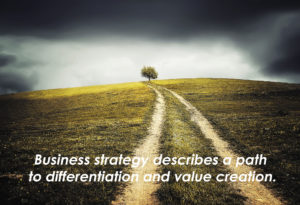A fever for growth and volume was driving this company toward bankruptcy until they developed a great strategy that turned them around, resulting in consistent value creation.
Under previous owners a manufacturing company with which I am fairly familiar was growing by grabbing any piece of business they could find. They were heavily dependent on the automotive industry, faced a large number of similar competitors, and were rapidly going broke. The management team bought the company just before bankruptcy and proceeded to define a new business strategy that made more sense.

Their new business strategy had five elements that defined where and how they would compete. First, it defined the sorts of products that they thought they could produce well, secondly it defined the kinds of markets that they hoped to serve, and then it described what the expectations would be of their target customers and the skills that they would need to offer. There were two primary markets that they wanted to serve and they were narrowly defined, both expensive equipment markets. They knew that the producers of this sort of high-priced equipment would have high expectations for quality and that suited the company just fine. By the nature of these equipment markets, they expected that customers would demand short runs and much smaller quantities than the norm that they had dealt with before their business had collapsed. Also these customers would demand quick order turnaround.
One of the benefits of defining this strategy and pursuing these market niches was a change in the competitive dynamics; the number of truly capable competitors would shrink from thousands to a mere handful and it would be difficult for international competitors to meet the delivery requirements. Another advantage would be that the relative cost of the components that this company would produce would be a tiny fraction of the purchased components for their target customers. The target customers would have limited choices and would willingly pay for the value that the company could provide. As they shrank the business and shifted to this new strategy, sales declined by more than 60% as they “fired” customers but profit margins shot upwards and the net result was very advantageous.
The new business strategy provided a guide for where they should seek business. Not every piece of new business meets all five of the criteria, but the company is never tempted to chase an order just to gain volume. Customers who need the value offering that is provided are willing to pay a reasonable price with reasonable margins. There are still a few competitors with a similar value offering but the business for which they now compete is not subject to cutthroat pricing.
Once they established the market to be pursued and the value offering to be provided, the new business strategy met the other purpose of a strategy statement: it began to drive every decision and every action. They asked themselves, “What core competencies do we need to build to produce these particular types of parts at an extremely high level of quality?” and “What core competencies do we need to develop to provide efficient processes for short runs and quick order turnaround?” So the strategy began to drive every decision – the people to hire, the machines to install, the skills to learn, the technologies to develop, the orders to pursue or not pursue, the way to organize, the services to offer, which capabilities must be in-house, processes and procedures, etc. Everyone in the company marches to the same tune; they know the strategy and what makes the company unique and successful.
More than 20 years later this company still uses this same business strategy. It has continued to build the core competencies that enable it to produce their selected parts at very high levels of quality and work as a job shop in a high-volume industry. They consistently generate strong margins and growing sales revenue. The right business strategy saved them from the fate of many of their former competitors and built them into a strong and successful supplier.
Does your organization have a business strategy that sets it apart from the competition, drives the company’s decisions, and builds long-term value?

Add your comment